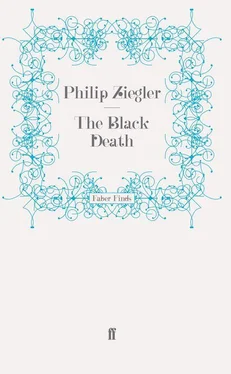Professor Stengers, the Belgian historian, referred wistfully to the riches of the English archives as being the envy of every continental medievalist. {234} Envy certainly; and yet it would be surprising if the continental historian did not sometimes feel a certain relief and the proud possessor of this treasure-house occasionally view his national glory with apprehension as well as pride. The knowledge that untapped reservoirs of knowledge exist, ready to confound the over-confident and ensnare the unwary, is sobering even to the expert and downright intimidating to the amateur.
This seems particularly true when material about the effects of the Black Death is in question. The most complete source, though by no means the most comprehensive, is the ecclesiastical records. Cardinal Gasquet relied almost exclusively on these for his study of the Black Death. The principal series which he used were the Books of Institutions, showing dates of appointment to the various livings, together with the Patent Rolls which listed, inter alia, ‘royal grants, licences and presentations made by the Sovereign to such vacant ecclesiastical livings as were at the time in the royal gift’. {235} The value of such records is obvious but, as will be seen later, so also are their limitations. For the moment it suffices to say that, as a rough guide to the date that the Black Death was raging in any particular area and to the relative damage which it did in one place or another, better evidence is rarely to be found.
Among the lay documents, those which are of immediate relevance for a study of the Black Death are the manorial Court Rolls. From these, in ideal circumstances, it is possible to establish how many householders died in any given period and whether there were relations left to inherit or the holding escheated to the Lord. Though once again such lists pose problems when it comes to deducing from them a comprehensive total of plague victims they are of the utmost value in that they show the incidence of the Black Death in each manor. Read in conjunction with the Account Rolls they provide an amazingly detailed picture of life on the medieval manor. But many fewer of them are left than is the case with the ecclesiastical documents and, as a general rule, they also tend to be less well kept and less accessible. A series is necessary to enable valuable deductions to be drawn – yet too often the series is interrupted and only isolated numbers survive.
With the help of the ecclesiastical records, it can be established that the plague was rife in many parts of Dorset by October 1348, reached a peak in December and January and was on the wane by the end of February. New vicars had to be appointed at Shaftesbury on 29 November, 10 December, 6 January and 12 May and Wareham lost the head of its Priory in October and had two new vicars instituted in December, one in May and another in June.
Exactly 100 institutions to Dorset benefices caused by the death of the previous incumbent were made during the seven months from October 1348 to April 1349. The numbers did not return to normal until the autumn of 1349. {236} From other sources one learns that Poole was particularly badly affected and that a tongue of land projecting into the sea and known as ‘The Baiter’ was bought by the town-councillors and set aside as a burial place for the victims. At Bridport, though the plague was not so bad as to interfere with the supply of cordage to the royal navy, {237} two additional bailiffs had to be appointed to cope with the extra work.
In January 1349 Ralph of Shrewsbury, Bishop of Bath and Wells, circulated a letter to all the priests in his diocese which shows up vividly the demoralization in the infected areas: {238}
The contagious pestilence of the present day, which is spreading far and wide, has left many parish churches and other livings in our diocese without parson or priest to care for their parishioners. Since no priests can be found who are willing, whether out of zeal and devotion or in exchange for a stipend, to take on the pastoral care of these aforesaid places, nor to visit the sick and administer to them the Sacraments of the Church (perhaps for fear of infection and contagion), we understand that many people are dying without the Sacrament of Penance. These people have no idea what recourses are open to them in such a case of need and believe that, whatever the straits they may be in, no confession of their sins is useful or meritorious unless it is made to a duly ordained priest. We, therefore, wishing, as is our duty, to provide for the salvation of souls and to bring back from their paths of error those who have wandered, do strictly enjoin and command, on the oath of obedience that you have sworn to us, you, the rectors, vicars and parish priests in all your churches, and you, the deans elsewhere in your deaneries where the comfort of a priest is denied the people, that, either yourselves or through some other person you should at once publicly command and persuade all men, in particular those who are now sick or should fall sick in the future, that, if they are on the point of death and can not secure the services of a priest, then they should make confession to each other, as is permitted in the teaching of the Apostles, whether to a layman or, if no man is present, then even to a woman. We urge you, by these present letters, in the bowels of Jesus Christ, to do this…. And, in case anyone might fear that a lay confessor would make public the confessions which they heard and, for this reason, might hesitate to confess himself to such a person even in time of need, you should announce to all in general and, in particular, to those who might hear confessions in this way, that they are bound by the laws of the Church to conceal and keep secret such confessions and that they are prohibited by sacred canonical decrees from betraying such confessions by word, sign, or any other means, except at the wish of those who have made such confession. If they break this law then they should know that they commit a most grievous sin and, in so doing, incur the wrath of Almighty God and of the whole Church.
The Bishop concluded:
The Sacrament of the Eucharist, when no priest is available, may be administered by a deacon. If, however, there is no priest to administer the Sacrament of Extreme Unction, then, as in other matters, faith must suffice.
Even with this exception, it is clear that the Bishop was authorizing a very considerable relaxation of the normal rules.
The authority to hear confession has, in all periods of the Church’s history, been restricted to the priesthood. To throw it open to laymen and even to women, though not in defiance of canonical authority, was a step to be taken only in case of extreme emergency. It was a confession on the part of the Church that the crisis was out of control and the normal machinery no longer able to cope with it.
The most revealing phrase in the Bishop’s letter is the one in which he refers to the lack of priests willing to take on new parishes or to visit the sick ‘perhaps for fear of infection and contagion’. The implied rebuke would have come better if Ralph of Shrewsbury himself had ventured a little farther into the battle. From November 1348 until 13 May 1349 the period in which the Black Death was at its height in all parts of his diocese, the Bishop remained at his house at Wiveliscombe, a remote village in the corner of his territory. {239} It is true that it was his normal practice to winter at Wiveliscombe and also only justice to say that he seems in no way to have neglected his duty or shunned direct contact with visitors from plague-infested areas. Indeed, a stream of priests came to his retreat to receive their letters of institution. No doubt he had good reason to argue, like Pope Clement before him, that the best way he could serve his flock was by staying alive and not indulging in false or, at least, futile heroics. But, when all is said and done, one would still have slightly greater respect for the Bishop and sympathy for his railing at the reluctant clergy if he had paid a single visit to Bristol, Bath or any other important town in his diocese while it was suffering the agonies of the plague.
Читать дальше












